Century-Old Jewish History on the Lower East Side Springs to Life with Virtual Tours by the Tenement Museum
By Sue Weston and Susie Rosenbluth – Two Sues on the Aisle
If this past year’s adjustment to the pandemic has made you feel claustrophobic, the Tenement Museum, one of Manhattan’s hidden-in-plain-sight treasures, can take you by Zoom to 97 Orchard Street, where, in 1908, the Rogarshevsky family of nine, recent immigrants from Telsch (then in Russia, now Lithuanian) shared three rooms.
A real-life Jewish family of six, who came to the United States in 1901, along with 2.5 million other Eastern European Jews between 1880 and 1920, the Rogarshevskys settled on the Lower East Side of Manhattan, then the densest Jewish-populated neighborhood in the city with the most Jews in the entire world. They came in search of economic opportunities and freedom from the relentless, dangerous antisemitism of the Old Country.
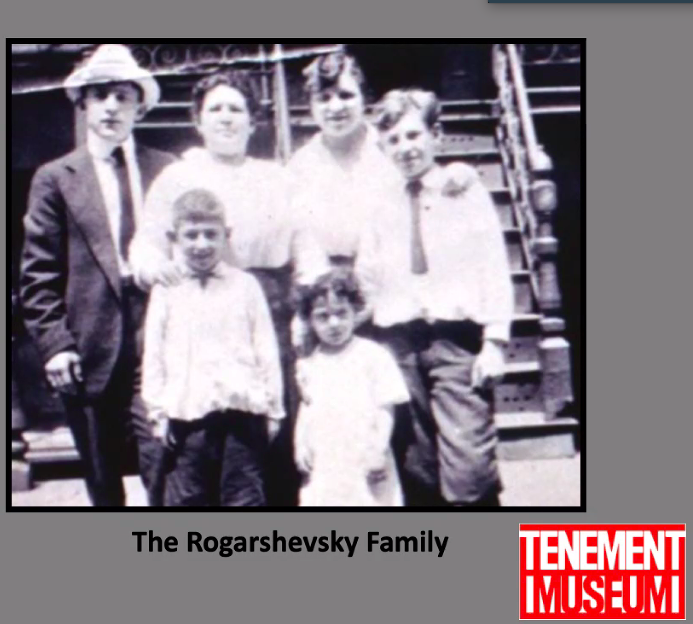
The Rogarshevsky Family outside 97 Orchard Street
Before the pandemic—and presumably to be resumed after the virus is under control—the museum enjoyed a reputation for its in-the-flesh walking tours, some of them complete with docents in costume, all devoted to New York’s immigrant heritage. These days, the staffers, called educators and “costumed interpreters,” do a credible job transporting participants back in time for a virtual glimpse into life on New York City’s Lower East Side in the years when bathrooms and toilets were shared in the hall and cold running water in the apartment itself was considered a luxury.
From 1863, when it was built, until 1941, when it was condemned for failing to meet fire-safety laws, 97 Orchard Street, the focal point of a recent Tenement Museum virtual tour, was home at one time or another to some 7,000 people from 20 different countries.
“We like to think of it as a container of stories,” says Grace McGookey, the museum’s lead educator.
Greenhorns
She began her tour by introducing Abram and Zipe Heller, ages 30 and 28, respectively, who left Hamburg by ship with their four children, Ida, 8, Bessie, 7, Morris, 6, and Samuel, 3, abandoning rural Russia for the noise, smells, and crowds of Orchard Street, where 2,800 people were packed into each square block.
By way of comparison, Ms. McGookey explains that these days, when much of that same area has been gentrified, each square block holds approximately 400-600 residents.
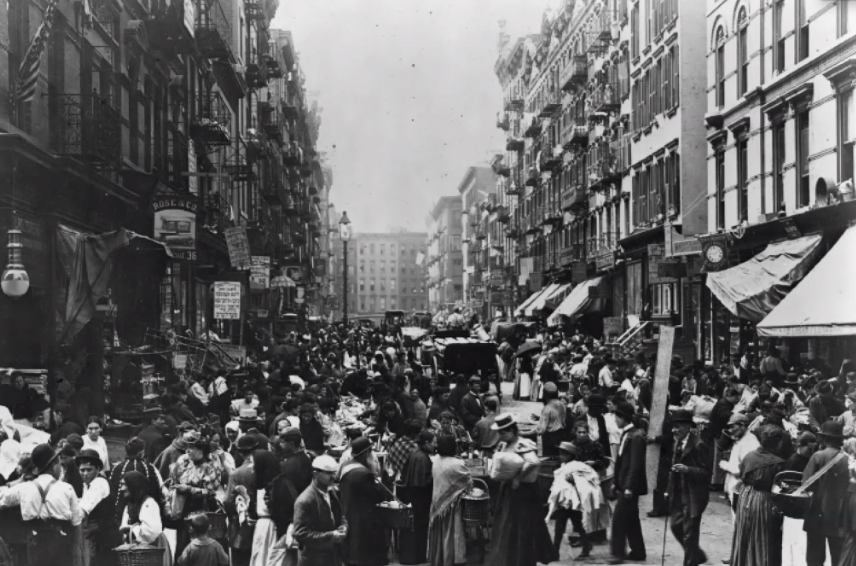
A day on Orchard Street
Perhaps symbolizing their hopes for a new beginning, the Hellers, upon landing in New York, recreated themselves as Abraham and Fanny Rogarshevsky, giving themselves the name of the uncle who had raised Abram.
Cramped Quarters
Each floor of the building at 97 Orchard Street held four identical three-room apartments, each offering the tenant families only a few hundred square feet of living space.
At bedtime, the Rogarshevskys’ linoleum-lined kitchen was repurposed into a bedroom for the family’s two daughters, who slept nose-to-toes in one bed.
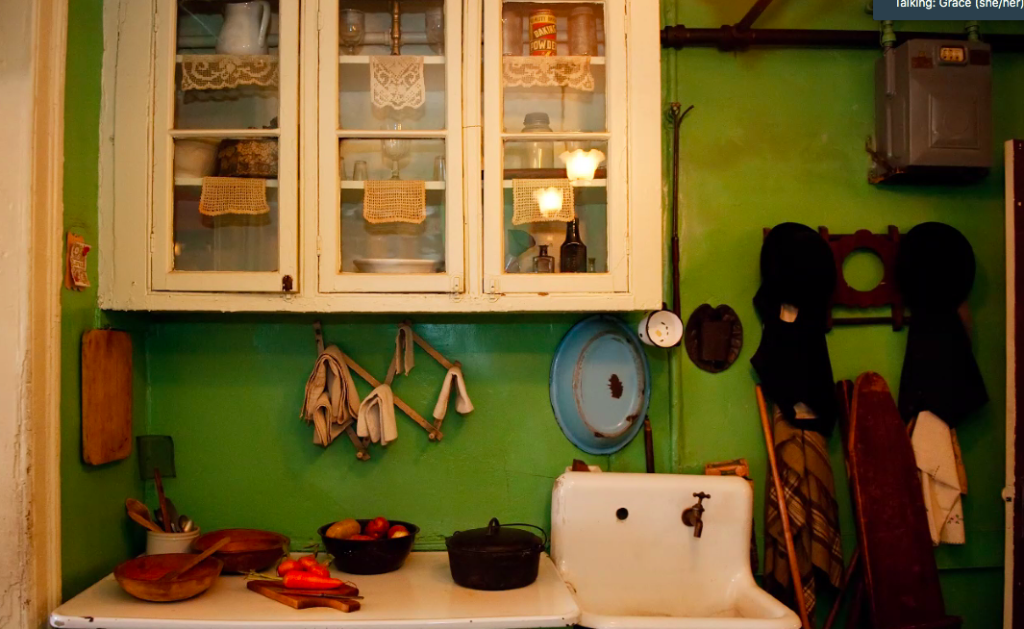
Rogarshevskys’ kitchen with a bed in the corner
The couch in the parlor, along with chairs and crates, served as beds for the family’s two older sons plus two younger boys, Henry and Philip, who were born in New York. In addition, for much-needed extra cash, the family took in a boarder who, eventually, would marry their second daughter, Bessie, and move with her to the Bronx.
Abraham and Fanny took the apartment’s small bedroom, with two windows opening onto an airshaft, a comparatively new innovation in 1907 when they moved in.
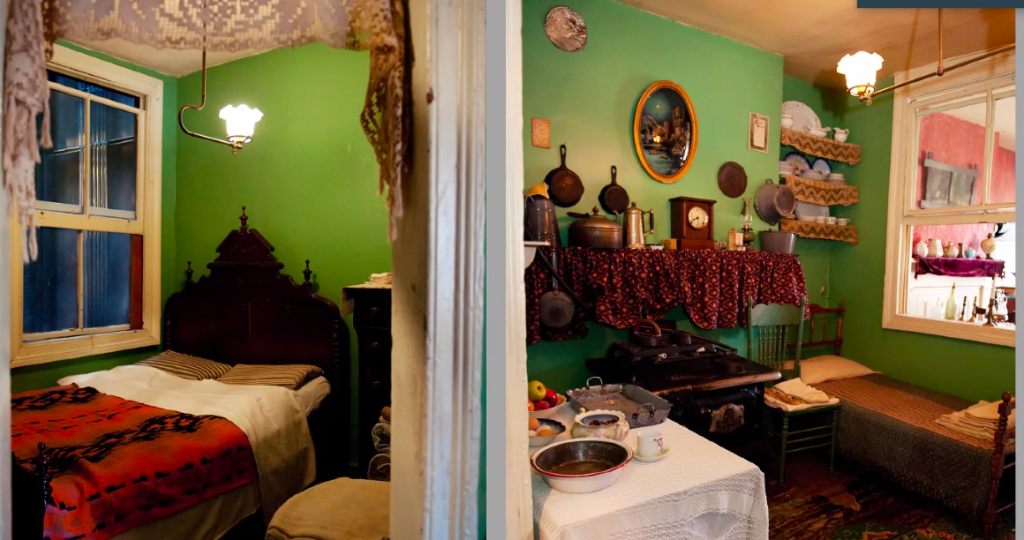
Rogarshevskys’ bedroom and living room at 97 Orchard Street
Indoor plumbing was also new. Each floor boasted two bathrooms to be shared by the tenants in all four apartments, but each family had its own sink with cold running water, which could be heated in the coal-burning stove with its gas burners. Like the other tenants in the building, the Rogarshevskys would put coins into their gas meter to pay for lights and cooking.
Rent for apartments such as this ranged from $12-$20 per month, which, according to Ms. McGookey, represented anywhere from one-third to one-half of the family’s income.
Hard Work
Earning that money was no easy trick. The tour included the opportunity to review a page from the 1910 Census, which showed that Abraham, who listed his occupation as a presser in a garment shop, was out of work for 13 weeks that year.
According to Ms. McGookey, that could have been for any of a number of reasons. “The small factories that would hire Abraham were open Monday through Saturday, but he was religious. If he didn’t work on Saturday, he would be told not to show up on Monday, which meant looking for another position. Maybe he had been injured on the job or out on the street,” she said.
In any case, everyone in the family worked except the three youngest sons, who were twelve, seven, and three, and Fanny, the mother, who spoke only Yiddish and not English, like the rest of them, and did not know how to read or write.
Ida, who was 17, was a joiner, which meant she constructed the wooden boxes the factories used to ship clothes; Bessie, at 16, was an operator of a sewing machine, probably making 75 blouses per week; and 15-year-old Morris worked as a shipping clerk for a laundry.
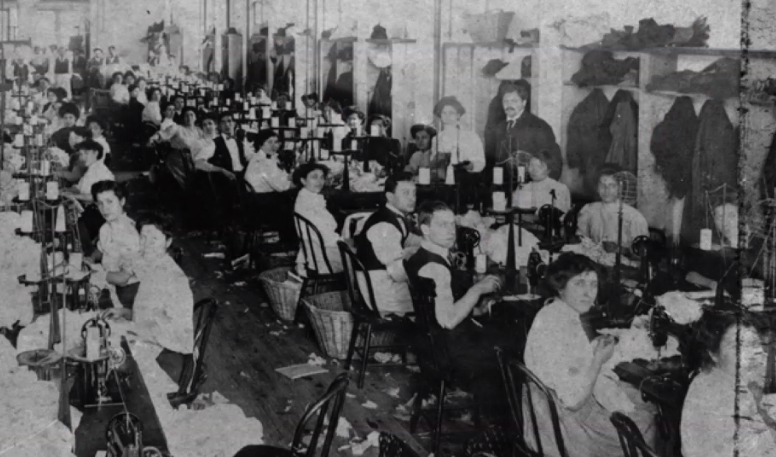
The overcrowded garment factories
Children over the age of 14 were allowed to leave school, and it is no surprise that the Rogarshevskys, like almost 60 percent of Jews on the Lower East Side at the time, were employed in the needle trade and connected in one way or another to the garment industry. Garment workers were paid by the piece, working ten-hour days, six days a week in dark-overcrowded factories, where they often had to pay to rent their own chairs.
But it wasn’t all grim, especially for the young people, for whom the factories offered a social outlet, a place to learn about and share new books, discuss the news, and congregate.
High Child Mortality
But the brutal toll of poverty and disease was apparent from the Census report. Every family listed on the page with the Rogarshevskys had suffered the loss of at least one child. Fanny was listed as having given birth to eight children, only six of whom survived. Only six of the 12 children born to her neighbor, Ida Dubin, were still alive in 1910.
In 1918, Abraham died of tuberculosis, a personal and economic catastrophe for the family. Out of necessity, Fanny took a job, becoming the janitress of the building at 97 Orchard Street. She cleaned the halls and its apartments, serving as the on-site, live-in superintendent until the building was finally condemned in 1941.
By that time, for reasons that have been lost to history, the family changed its name again, becoming Rosenthal.
“When one of the sons was asked why they did that, he said they liked the name and it began with an ‘R,’” says Ms. McGookey.
Very much a Jewish grandmother, Fanny maintained the tenement apartment as a place of refuge for her children and grandchildren, inviting them every week to spend Shabbos with her. When Bessie’s husband died, she brought her three children to move back in with her mother.
“Always religious, Fanny wouldn’t turn on lights on the Sabbath. She always had one of the Italian-immigrant girls in the building help her,” says Ms. McGookey.
Specific Time and Place
As much as the Tenement Museum spotlights the individual family as a microcosm, there is also an effort to place it in time and place economically and socially.
Ms. McGookey explained that the factories at the time were bent on reducing theft and increasing productivity, and, as such, failed to recognize the risks until Saturday, March 25, 1911, when a fire erupted in the Triangle Shirtwaist Factory. Locked doors, ineffective fire equipment, and overcrowding resulted in the deaths of 145 garment workers, most of them young women, who were unable to escape.
The disaster brought awareness to the poor working conditions in these sweatshops, and media attention and public outcry combined to bring about labor reforms.
Ms. McGookey asked participants to consider how the Rogarshevskys, with daughters the same age as many of those who died, might have responded to the tragedy.
Many Families
When the museum holds its regular walking tours, participants are able to see how history is brought to life utilizing personal objects and living conditions frozen in time for almost 120 years. In the dark recesses of the entry hall, virtual footsteps echo in the small confines, and the tour guide’s questions prompt observations and understanding.
The Rogarshevskys of Orchard Street represents just one of the families in the Tenement Museum’s roster of early immigrants to the Lower East Side. Another tour is a journey back to 1916 to meet Victoria Confino, a Sephardic 14-year-old who immigrated to the United States in 1913. An even earlier time-trip takes participants back to 1874 to visit Schneider’s Saloon, run by German immigrants John and Caroline, the first residents of 97 Orchard Street.
Important Mission
Ms. McGookey, whose theatrical training lends professionalism to the experience, agrees the museum’s programs would make for a fascinating, fun way to celebrate a birthday or bat mitzvah, whether in person or online.
The museum’s mission is to foster a society that embraces and values the role of immigration in the evolving American identity through guided tours; curriculum and programs for secondary and post-secondary educators; stories, primary sources, and media shared on its website; and interactive online experiences such as Your Story, Our Story, podcasts, and more.
In fact, the museum’s virtual presence has opened its programs to a whole new audience, making it possible for groups across the country to participate in these highly enjoyable, interactive-hour tours. School groups especially should consider this as a way to make history come alive without the mess or stress of on-the-ground travel.
Ways to Check It Out
By checking out https://www.tenement.org/tours/ those interested in learning more about the immigrant experience can discover all sorts of virtual one-hour tours and programs the museum is offering for adults and youngsters.
The long history of 97 Orchard Street, with its waves of various immigrations, including a stint from 1889-1902 as home to Lustgarten’s Kosher Butcher Shop, where windows were broken during the kosher meat riots, can be found at https://www.tenement.org/explore/97-orchard-street/
For more information, the museum can be reached at 877-975-3786.
“At a time when issues surrounding migrants, refugees, and immigration have taken center stage, the Tenement Museum is a potent reminder that, as a nation shaped by immigration, our brightest hope for the future lies in the lessons of the past,” says Ms. McGookey.
***
Two Sues on the Aisle bases its ratings on how many challahs it pays to buy (rather than make) in order to see the play, show, film, or exhibit being reviewed.

Five Challah Rating
The Tenement Museum received 5 challahs.





